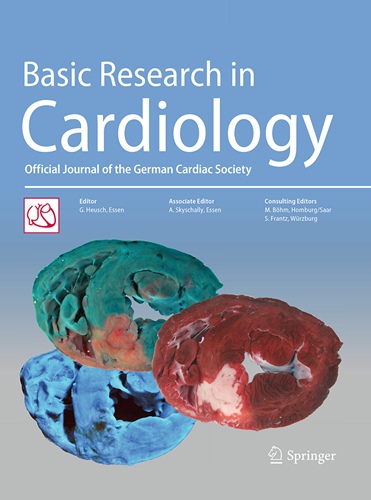TCF19和ATAD2的下调导致内皮细胞周期在心脏肥厚到心力衰竭的转变过程中停止。
IF 8
1区 医学
Q1 CARDIAC & CARDIOVASCULAR SYSTEMS
引用次数: 0
摘要
心脏肥厚是心脏适应负荷增加的关键机制,但从长期来看,它与心力衰竭、心律失常和死亡的高风险相关。在肥厚生长过程中,心肌细胞通过血管内皮生长因子(VEGF)向内皮细胞发出信号,促进血管生成,维持心肌供氧。血管生成不足导致毛细血管密度下降,导致代偿性心脏肥厚向心力衰竭发展。在这里,我们研究了心力衰竭发生过程中内皮细胞基因表达的时间过程,并确定了细胞增殖和血管生成的转录调节因子。我们在小鼠和分离的心脏内皮细胞中应用横断主动脉收缩术(TAC),在6小时和1、3、7或28天后进行RNA测序,以创建心脏肥厚和衰竭过程中的基因表达清单。超声心动图显示失代偿性心力衰竭发生在TAC后第7天至第28天。同时,我们观察到内皮细胞基因表达的转换,在肥大状态下增殖标记上调,而在失代偿性心力衰竭时下调。值得注意的是,尽管心肌细胞发出强烈的VEGF信号,内皮细胞周期仍发生阻滞,这表明VEGF具有耐药性。为了研究内皮细胞增殖是如何被转录调控的,我们进行了加权基因共表达网络分析,并鉴定了180个细胞周期相关基因的模块。我们预测转录因子19 (TCF19)、atp酶家族AAA结构域2 (ATAD2)和转录因子Dp-1 (TFDP1)是该基因模块的中心调控因子。在HUVECs中,siRNA敲低TCF19和ATAD2导致增殖标志物MKI67下调,抑制细胞增殖、管形成和细胞迁移,证实了它们的调节功能。主动脉瓣狭窄患者的心脏组织活检中,TCF19和ATAD2丰度与内皮细胞增殖呈正相关。TCF19或ATAD2控制参与内皮细胞增殖和血管生成的基因网络的表达。TCF19和ATAD2的下调与内皮细胞周期阻滞和对VEGF信号的血管生成反应受损有关,这可能促进代偿性心脏肥厚向心力衰竭的转变。本文章由计算机程序翻译,如有差异,请以英文原文为准。
Downregulation of TCF19 and ATAD2 causes endothelial cell cycle arrest at the transition from cardiac hypertrophy to heart failure.
Cardiac hypertrophy is a key mechanism that allows the heart to adapt to increased load, but in the long term is associated with a higher risk for heart failure, arrhythmia, and death. During hypertrophic growth, cardiac myocytes signal to endothelial cells via vascular endothelial growth factor (VEGF) to promote angiogenesis and maintain myocardial oxygen supply. Insufficient angiogenesis leads to a decline in capillary density and drives the progression from compensated cardiac hypertrophy to heart failure. Here, we studied the time course of endothelial cell gene expression during heart failure development and identified transcriptional regulators of cell proliferation and angiogenesis. We applied transverse aortic constriction (TAC) in mice and isolated cardiac endothelial cells for RNA sequencing after 6 h and 1, 3, 7, or 28 days to create an inventory of gene expression during the course of cardiac hypertrophy and failure. Echocardiography revealed that decompensated heart failure occurred between days 7 and 28 after TAC. At the same time, we observed a switch in endothelial cell gene expression with an upregulation of proliferation markers in the hypertrophy state but downregulation in decompensated heart failure. Of note, endothelial cell cycle arrest occurred despite strong VEGF signaling from cardiac myocytes, indicating VEGF resistance. To investigate how endothelial cell proliferation is transcriptionally regulated, we performed a weighted gene co-expression network analysis and identified a module of 180 cell cycle-related genes. We predicted transcription factor 19 (TCF19), ATPase family AAA domain containing 2 (ATAD2), and transcription factor Dp-1 (TFDP1) to be central regulators of this gene module. Knockdown of TCF19 and ATAD2 by siRNA in HUVECs led to a downregulation of the marker of proliferation MKI67 and repressed cell proliferation, tube formation, and cell migration, confirming their regulatory function. In heart tissue biopsies from patients with aortic stenosis, TCF19 and ATAD2 abundance were positively correlated with endothelial cell proliferation. TCF19 or ATAD2 control the expression of a gene network involved in endothelial cell proliferation and angiogenesis. Downregulation of TCF19 and ATAD2 is associated with endothelial cell cycle arrest and an impaired angiogenic response to VEGF signaling that may promote the transition from compensated cardiac hypertrophy to heart failure.
求助全文
通过发布文献求助,成功后即可免费获取论文全文。
去求助
来源期刊

Basic Research in Cardiology
医学-心血管系统
CiteScore
16.30
自引率
5.30%
发文量
54
审稿时长
6-12 weeks
期刊介绍:
Basic Research in Cardiology is an international journal for cardiovascular research. It provides a forum for original and review articles related to experimental cardiology that meet its stringent scientific standards.
Basic Research in Cardiology regularly receives articles from the fields of
- Molecular and Cellular Biology
- Biochemistry
- Biophysics
- Pharmacology
- Physiology and Pathology
- Clinical Cardiology
 求助内容:
求助内容: 应助结果提醒方式:
应助结果提醒方式:


